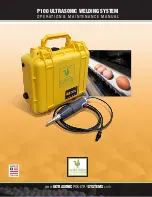
9
BREWING INSTRUCTIONS
C.
After first clarification.
D.
Second clarification complete, clear beer
present in top of sediment bottle.
06.
The final stages of fermentation can be seen
when there are a few fine bubbles or the
occasional yeast ‘bombs’ rising from the yeast
bed in the sediment bottle. Shortly following
this you will see a clear layer of compacted
sediment with cloudy liquid above it. There will
be no sign of yeast activity after your fermentation
is complete.
07.
If you think fermentation may not be complete,
it is always safe to wait an additional day.
08.
Once fermentation is complete, it is time to chill
your beverage to prepare it for clarification.
09.
Move your BrewKeg10
TM
to your refrigerator and
chill your beer or cider to 1-3ºC (34-37.5ºF).
10.
Wait 6 hours for the vessel and liquid to cool
before commencing clarification.
NOTE: CO
2
pressure indicated on the Pressure Gauge will
reduce slightly as CO
2
is absorbed from the head space of
the BrewKeg10
TM
into the cooled beverage.
CLARIFICATION
CIDER CLARIFICATION
Cider does not need to be clarified. It clears
naturally within 24-36 hours, the closer to
1ºC (34ºF), the more efficient the clarification.
Once the cider is clear, you can progress to the
DISPENSE
stage.
BEER CLARIFICATION
You may need to dump your sediment bottle
prior to commencing the clarification step if your
sediment bottle is more than half full. This may
occur if you are brewing a high alcohol beer or
one with many steeped hops. If required, please
follow the instructions regarding dumping of the
sediment bottle.
01.
Prepare your gas bottle, regulator and gas line.
Set your gas bottle outward pressure to 1.1 bar
(16 psi). Refer to WilliamsWarn Video Resources
to set up and use your gas bottle.
02.
Wind the VPRV valve to a fully closed position
and close the bottom valve.
03.
Unscrew the lid of the Dosing Device and
measure 15ml (0.5 fl. oz.) of Clarification Agent
into the device. Screw the lid back on.
04.
Connect the Gas-Disconnect (Grey) fitting from
the gas bottle to the lid of the Dosing Device.
05.
Press the VPRV valve on the BrewKeg10
TM
lid
until the pressure gauge reads 0.6 bar (9 psi).
06.
Connect the Liquid-Disconnect (Black) fitting
from the Dosing Device to the liquid out post
on the BrewKeg10
TM
(marked ‘L’ on the lid). The
difference in pressure ensures the Clarification
Agent immediately bubbles through the liquid.
You should hear the bubbling.
07.
Keep the Liquid-Disconnect (Black) attached
until the pressure in the BrewKeg10
TM
is the
same as the gas bottle (1.1 bar / 16psi), then
disconnect from the BrewKeg10
TM
.
08.
To flush the Clarification Agent residue from the
dosing device add 30ml (1 fl. oz.) of cold water
to the dosing device, install the lid and shake
to clean all surfaces, before connecting back to
the liquid out post and flushing the water into
the BrewKeg25
TM
by releasing a small amount
of pressure from the vessel while it is connected
to the Gas-Disconnect (Grey). Let the pressure
equalise back to 1.1 bar before disconnecting.
09.
Disconnect the Dosing Device from the gas line
and liquid post and remove the pressure gauge.
10.
Connect the Gas-Disconnect (Grey) of the gas
bottle to the gas post on the BrewKeg10
TM
set at
1.1 bar (16psi).
11.
Open the bottom valve. The beer will now clarify
and dump a new layer of yeast and haze into the
sediment bottle.
12.
You will see a separation of clearer beer and
sediment appearing in your sediment bottle.
13.
After 12 hours, repeat steps 3-12 with 10ml
(0.34 fl. oz.) of Clarification Agent.
14.
A third yeast and haze layer will fall into the
sediment bottle over the next 24 hours.
15.
When you see a clear line of crystal clear beer
above the compacted sediment in your sediment
bottle, you are now ready to enjoy your beer!
Содержание BrewKeg10
Страница 2: ...VERSION 01...
Страница 17: ...1 1 BREWING INSTRUCTIONS NOTES...
Страница 18: ...1 1 USER GUIDE NOTES...
Страница 19: ...1 1 BREWING INSTRUCTIONS NOTES...
Страница 20: ......






































